In 2010, Sony introduced its mirrorless interchangeable lens cameras with one mount called the “E-mount”. This mount became the only mount for both full frame and APS-C cameras. Sony launched its first full-frame mirrorless camera, the Sony A7 in 2013.
Very rapidly, Sony lenses become one of the best camera lenses to buy. They have four lens series, the top series is the G Master lenses (they are big, expensive, and top quality) for professional photographers, and the other three series are G, standard, and ZEISS for photographers and videographers who need lenses that are lighter, smaller, not quite so expensive, and for certain shooting needs.
Sony has its unique lens abbreviations system, for the full list of lens abbreviations; you can check my post “Camera Lens Abbreviations”
Here are some of them:
- E: E mount lens for APS-C
- EF: Full frame E mount lens
- OSS: Optical Steady Shot (Image stabilization system)
- ZA: Zeiss Alpha, Zeiss branded lens designed for Sony cameras.
- T*: A special coating on a Carl Zeiss lens to prevent flaring, ghosting
No matter what you are looking for, I hope this tutorial will help you take advantage of the features and quality of your Sony camera.
Image Sensor sizes
Sony uses the common sensor sizes: the full frame and APS-C, among the many sensor sizes in common use, the full-frame is considered a large size while APS-C is a medium size. Both are popular as a result of their individual advantages.
Sony APS-C sensor has dimensions of 23.5mm x 15.6mm (width x height)
The full-frame sensor has dimensions of 36mm x 24mm (width x height)
Further reading: “Difference Between A Full Frame And A Crop Sensor”
Sony lens mounts
Sony produces cameras with two lens mount systems: A-mount and E-mount. A-mount is standard on Sony DSLR camera bodies, while E-mount is used on mirrorless bodies.
You may check my post “Difference Between DSLR And Mirrorless Cameras”
In this post, I will stick to the lenses for the mirrorless cameras, the “E” mount
The E-mount connects APS-C to full-frame, Alpha mirrorless cameras to pro camcorders, and entry-level to high-end gear. Use full-frame lenses on APS-C bodies, and even attach E-mount lenses to professional camcorders.

Lens and sensor combinations
Sony offers full-frame and APS-C lenses with image circles that cover the corresponding sensor formats. Although lenses are usually chosen to match the sensor format, different combinations can be used to vary the crop area and angle of view when broader coverage or extra telephoto reach is desired.
The figures below show the various combinations of camera and lens types.


Sony Lens Series
Sony has arranged its lenses into different series. Different series indicate specific feature sets or designs as well as the user types to which they are best suited. These series are:
- G Master: Gold (G) master (M) is Sony’s new highest-quality range of lenses. It is Sony’s top-of-the-line; G Master Lenses displays the highest resolution, smoothest bokeh, and most robust construction details to match their flagship camera bodies. Spanning a wide range of focal lengths and emphasizing speed, G Master lenses also make use of the most refined optical and focusing technologies available.
- G: Gold (G) is Sony’s old highest-quality range of lenses. It is Sony’s second tier in lens design, these lenses balance optical excellence with more compact and modest designs compared to G Master Lenses. It covers a versatile range of focal lengths and is comprised of both zooms and primes.
- ZEISS: Made in collaboration with ZEISS, these lenses blend Sony’s manufacturing with optical designs and construction details from the legendary German optics manufacturer. Utilizing specialized low dispersion glasses and their famous T* anti-reflective coating, these lenses offer a characteristic quality along with distinct physical designs and focal lengths.
- Standard: Outside of the specialized lens series designations, Sony produces a wide range of additional lenses to suit nearly any shooting need, from landscape to portraiture to wildlife, and are suitable for use on their expansive lineup of camera types, from the flagship pro bodies to the compact carry-everywhere cameras.
Prime vs zoom lens
Sony also offers both prime and zoom lenses. A prime lens has a fixed focal length, which means it cannot zoom from one length to another. While a zoom lens is simply a lens that offers a range of focal lengths all in one, rather than just one focal length. The pros and cons of both prime and zoom lenses are listed below.
| Feature | Prime lens | Zoom lens |
|---|---|---|
| Size | smaller | bigger |
| Weight | lighter | heavier |
| Versatility | you have to walk nearer or away from drom your subjet | allow you to take a closer or farther composition of your subject |
| flexibility | Youu need more np of lenses to cover certaln foacal range | you can carry fewer lenses in your camera bag to cover the same focal range |
| Image Quality | higher image quality | they can have less image quality |
| Bokeh | best for bokeh | they are not as good as prime lenses |
| Low Light | can be used in low light suitation | difficult to shoot in low light |
| Maximum Aperture | they offer wider apertures (faster) | they offer less wide aperture (slowe) |
| DOF | shallower depth of field | deeper depth of field |
Best Sony Digital Camera Lenses
Below is our list of the Best Sony Digital Camera Lenses:
- Sony E 10-18mm f/4 OSS (ultra-wide-angle) E OSS
- Sony FE 14mm f/1.8 GM (ultra-wide-angle prime) FE GM
- Sony FE 24mm f/1.4 GM (premium wide-angle prime) FE GM
- Sony FE 12-24mm f/4 G (Best ultra-wide-angle) FE G
- Sony FE 16-35mm f/2.8 GM (Best wide-angle) FE GM
- Sony E 16-55mm f/2.8 G E G
- Sony FE 35mm f/1.8 (versatile prime) FE
- Sony Planar T* FE 50mm f/1.4 ZA (all-around FOV) FE ZA
- Sony E 18-135mm f/3.5-5.6 OSS (best for travel) E OSS
- Sony E PZ 18-105mm f/4 G OSS (Best budget) E G OSS
- Sony FE 85mm f/1.4 GM Lens (for portraits) FE GM
- Sony FE 90mm f/2.8 Macro G OSS (Best for macro) FE G OSS
- Sony FE 24-70mm f/2.8 G Master (Best overall) FE GM
- Sony FE 135mm f/1.8 GM (Best for portraits) FE GM
- Sony E 55-210mm f/4.5-6.3 OSS (travel zoom lens) E OSS
- Sony E 70-350mm f/4.5-6.3 G OSS (travel zoom lens) E G OSS
-
Sony E 10-18mm f/4 OSS
E OSS
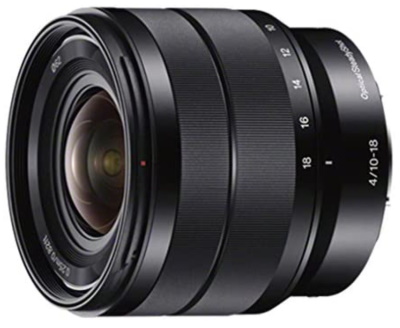
Take on ultra-wide landscapes or tight interiors with your APS-C-format E-mount camera using the E 10-18mm f/4 OSS Lens from Sony. Delivering a super wide 15-27mm equivalent zoom range, and offering a constant f/4 aperture, this lens can produce high-quality images in a variety of difficult scenarios. Implementing one Super ED and three aspherical elements guarantees image quality by minimizing aberrations throughout the range. In addition, the lens is equipped with Optical SteadyShot image stabilization for reducing the effects of camera shake
Pros
- Compact and lightweight
- Constant f/4 aperture
- Optical SteadyShot
Cons
- Mediocre corner-sharpness
- Not weather-sealed
- Pricey for its type
Specification
| Focal Length | 10 to 18mm (35mm Equivalent Focal Length: 15 to 27mm) |
|---|---|
| Max Aperture | f/4 |
| Min Aperture | f/22 |
| Lens Mount | Sony E |
| Lens Format | APS-C |
| Angle of View | 109° to 76° |
| Min Focus Distance | 9.84" / 25 cm |
| Max Magnification | 0.1x |
| Diaphragm Blades | 7, Rounded |
| Focus Type | Autofocus |
| Image Stabilization | Yes |
| Filter Size | 62 mm (Front) |
| Dimensions (ø x L) | 2.76 x 2.5" / 70.1 x 63.5 mm |
| Weight | 7.94 oz / 225 g |
2- Sony FE 14mm f/1.8 GM
FE GM
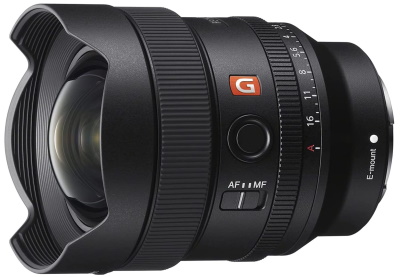
Pairing an ultra-wide-angle focal length with an especially bright design, the FE 14mm f/1.8 GM from Sony is a fast and dynamic lens well-suited to landscape, nature, architectural, and astrophotography applications. Its extremely wide perspective is complemented by an f/1.8 maximum aperture for excellent performance in low-light conditions and its impressively compact form factor makes it a portable and versatile option for everything from casual walkaround shooting to staged architectural shoot
Pros
- Excellent optical performance
- Light, compact build for drones and gimbals
- Dust, splash, and smudge protection
- Bright aperture for low-light work
- Rear filter support
Cons
- Some focus breathing is visible
- Not as versatile as a wide-zoom
Specification
| Focal Length | 14mm |
|---|---|
| MaxiAperture | f/1.8 |
| Min Aperture | f/16 |
| Lens Mount | Sony E |
| Lens Format | Full-Frame |
| Angle of View | 114° |
| Min Focus Distance | 9.8" / 25 cm |
| Max Magnification | 0.1x |
| Diaphragm Blades | 9, Rounded |
| Focus Type | Autofocus |
| Image Stabilization | No |
| Filter Size | Gel Filter (Rear) |
| Dimensions (ø x L) | 3.3 x 3.9" / 83 x 99.8 mm |
| Weight | 1 lb / 460 g |
-
Sony FE 24mm f/1.4 GM
FE GM
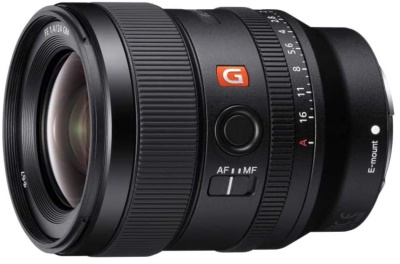
Combining a favored wide-angle focal length with an especially bright design, the FE 24mm f/1.4 GM from Sony is a fast, versatile lens well-suited to landscape, astrophotography, and street shooting applications. The f/1.4 maximum aperture complements its wide perspective and the lens is distinguished by a sleek, portable profile for all-day shooting.
Pros
- Bright, f/1.4 aperture.
- Light and compact.
- Dust, splash, and fluorine protection.
- Aperture ring with selectable detents.
Cons
- Pricier than some other options.
Specification
| Focal Length | 24mm |
|---|---|
| Max Aperture | f/1.4 |
| Min Aperture | f/16 |
| Lens Mount | Sony E |
| Lens Format | Full-Frame |
| Angle of View | 84° |
| Minimum Focus Distance | 9.45" / 24 cm |
| Maximum Magnification | 0.17x |
| Focus Type | Autofocus |
| Image Stabilization | No |
| Filter Size | 67 mm (Front) |
| Dimensions (ø x L) | 2.97 x 3.64" / 75.4 x 92.4 mm |
| Weight | 15.7 oz / 445 g |
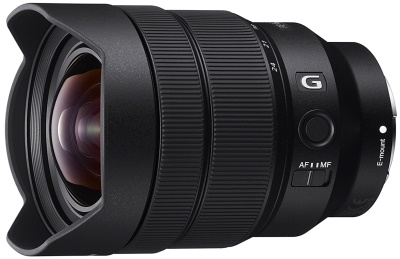
Ultra-wide and versatile, the Sony FE 12-24mm f/4 G is a flexible, everyday wide zoom characterized by its nimble design and well-rounded performance that makes it ideal for architectural, interior, and landscape subjects. In addition, as a G Lens, priority has been given to the optical design, which specifically helps to reduce distortion and achieve high sharpness across the frame for accurate rendering and high resolution.
Pros
- Light, compact design.
- Quite sharp.
- Extremely wide field of view.
- Integrated lens hood.
- Focus Hold button.
- Dust- and moisture-resistant construction.
Cons
- Omits filter thread.
- No stabilization.
- Muddy corners at wide apertures.
- Noticeable vignette.
- Distortion throughout range
Specification
| Focal Length | 12 to 24mm |
|---|---|
| Max Aperture | f/4 |
| Min Aperture | f/22 |
| Lens Mount | Sony E |
| Lens Format | Full-Frame |
| Angle of View | 122° to 84° |
| Minimum Focus Distance | 11.02" / 28 cm |
| Maximum Magnification | 0.14x |
| Diaphragm Blades | 7, Rounded |
| Focus Type | Autofocus |
| Image Stabilization | No |
| Filter Size | None |
| Dimensions (ø x L) | 3.43 x 4.62" / 87 x 117.4 mm |
| Length at Maximum Extension | 4.61" / 117 mm |
| Weight | 1.24 lb / 565 g |
-
Sony FE 16-35mm f/2.8 GM
FE GM
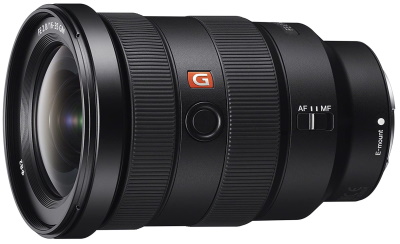
Offering G Master performance in a compact, fast, and versatile form, the Sony FE 16-35mm f/2.8 GM is a wide-angle zoom covering ultra-wide to standard wide-angle fields of view. Ideal for a range of subjects, from landscape to lifestyle to architecture, the lens’s advanced optics and bright f/2.8 design pair with a flexible zoom design to suit working in a variety of shooting conditions.
Pros
- Very sharp
- Lightweight for the focal range
- Rugged and durable
- Versatile focal range
Cons
- Expensive
- No Image Stabilization
Specification
| Focal Length | 16 to 35mm |
|---|---|
| Max Aperture | f/2.8 |
| MinAperture | f/22 |
| Lens Mount | Sony E |
| Lens Format | Full-Frame |
| Angle of View | 107° to 63° |
| Minimum Focus Distance | 11" / 28 cm |
| Maximum Magnification | 0.19x |
| Optical Design | 16 Elements in 13 Groups |
| Diaphragm Blades | 11, Rounded |
| Focus Type | Autofocus |
| Image Stabilization | No |
| Filter Size | 82 mm (Front) |
| Dimensions (ø x L) | 3.5 x 4.8" / 88.5 x 121.6 mm |
| Length at Maximum Extension | 5.4" / 136.2 mm |
| Weight | 1.5 lb / 680 g |
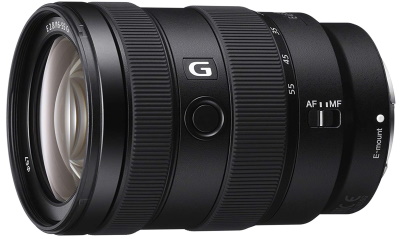
Positioned as the workhorse lens for APS-C, the Sony E 16-55mm f/2.8 G is a flexible wide-angle to portrait-length zoom featuring a bright constant f/2.8 maximum aperture. Covering a versatile range, this sleek lens is well-positioned for a wide variety of subjects, from landscapes to portraiture, and its portable size makes it a go-to lens for everyday shooting.
Pros
- lightweight/compact design
- image quality
- fast aperture
Cons
- extends with zoom
- some distortion at wide focal lengths
- high price
Specification
| Focal Length | 16 to 55mm (35mm Equivalent Focal Length: 24 to 82.5mm) |
|---|---|
| Max Aperture | f/2.8 |
| Min Aperture | f/22 |
| Lens Mount | Sony E |
| Lens Format Coverage | APS-C |
| Angle of View | 83° to 29° |
| Minimum Focus Distance | 1.08' / 33 cm |
| Maximum Magnification | 0.2x |
| Diaphragm Blades | 9, Rounded |
| Focus Type | Autofocus |
| Image Stabilization | No |
| Filter Size | 67 mm (Front) |
| Dimensions (ø x L) | 2.87 x 3.94" / 73 x 100 mm |
| Length at Maximum Extension | 5.3" / 133.8 mm |
| Weight | 1.09 lb / 494 g |
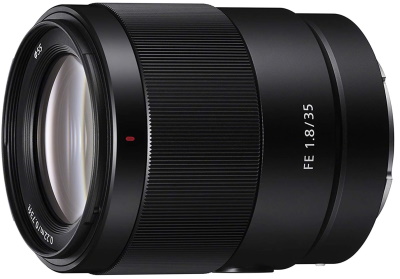
The Sony FE 35mm f/1.8 mixes a versatile wide-angle focal length with a bright design and a sleek form factor. As a wide-angle, this lens excels in a variety of situations, from street shooting to landscapes to travel, and the f/1.8 maximum aperture suits working in available lighting and benefits controlling depth of field.
Pros
- Good wide-open resolution.
- Excellent when stopped down.
- Light, compact build.
- Dust and splash protection.
Cons
- Pricey.
Specification
| Focal Length | 35mm |
|---|---|
| Max Aperture | f/1.8 |
| Min Aperture | f/22 |
| Lens Mount | Sony E |
| Lens Format | Full-Frame |
| Angle of View | 63° |
| Minimum Focus Distance | 8.7" / 22.1 cm |
| Maximum Magnification | 0.24x |
| Diaphragm Blades | 9, Rounded |
| Focus Type | Autofocus |
| Image Stabilization | No |
| Filter Size | 55 mm (Front) |
| Dimensions (ø x L) | 2.58 x 2.87" / 65.6 x 73 mm |
| Weight | 9.9 oz / 281 g |
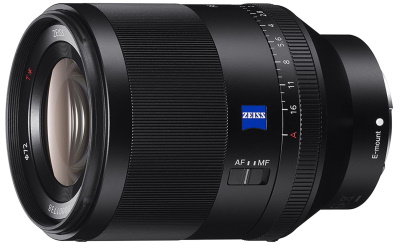
With its normal perspective, fast maximum aperture, and high-end design, the Planar T* FE 50mm f/1.4 ZA Lens from Sony is easy to see as a go-to standard optic for full-frame E-mount shooters. The 50mm focal length excels as an all-around field of view, suitable for portraiture, landscapes, and more, and the bright design offers creative depth of field control and low-light performance
Pros
- Superb sharpness.
- No distortion.
- Solid, weather-sealed build.
- Physical aperture control.
- Bright f/1.4 aperture.
Cons
- Omits optical stabilization.
- Dim corners at wide apertures.
Specification
| Focal Length | 50mm |
|---|---|
| Max Aperture | f/1.4 |
| Min Aperture | f/16 |
| Lens Mount | Sony E |
| Lens Format | Full-Frame |
| Angle of View | 47° |
| Minimum Focus Distance | 1.48' / 45 cm |
| Maximum Magnification | 0.15x |
| Diaphragm Blades | 11, Rounded |
| Focus Type | Autofocus |
| Image Stabilization | No |
| Filter Size | 72 mm (Front) |
| Dimensions (ø x L) | 3.29 x 4.25" / 83.5 x 108 mm |
| Weight | 27.5 oz / 780 g |
9- Sony E 18-135mm f/3.5-5.6 OSS
E OSS
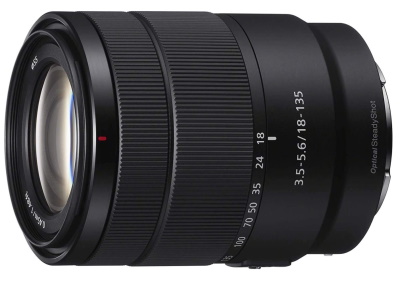
Spanning a useful wide-angle to medium telephoto range, the E 18-135mm f/3.5-5.6 OSS from Sony is a versatile 27-202.5mm equivalent zoom for APS-C-format E-mount mirrorless cameras. This well-rounded lens suits working in a variety of situations, making it an ideal zoom for travel applications, and the image stabilization helps to minimize the appearance of camera shake for sharper imagery when shooting handheld.
Pros
- Minimal distortion and vignette.
- Zoom power: 7.5x.
- 1:3.4 magnification.
- Optical stabilization.
Cons
- No dust or splash protection.
- Dim aperture.
- Not as wide-angle as some other options.
Specification
| Focal Length | 18 to 135mm (35mm Equivalent Focal Length: 27 to 202.5mm) |
|---|---|
| Max Aperture | f/3.5 to 5.6 |
| Min Aperture | f/22 to 36 |
| Lens Mount | Sony E |
| Lens Format | APS-C |
| Angle of View | 76° to 12° |
| Minimum Focus Distance | 1.48' / 45 cm |
| Maximum Magnification | 0.29x |
| Diaphragm Blades | 7, Rounded |
| Focus Type | Autofocus |
| Image Stabilization | Yes |
| Filter Size | 55 mm (Front) |
| Dimensions (ø x L) | 2.65 x 3.46" / 67.2 x 88 mm |
| Length at Maximum Extension | 4.41" / 111.9 mm |
| Weight | 11.5 oz / 326 g |
-
Sony E PZ 18-105mm f/4 G OSS
E G OSS
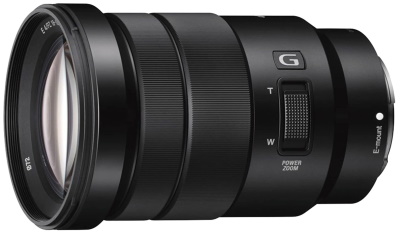
Have all the essential focal lengths covered with this E PZ 18-105mm f/4 G OSS Lens from Sony. Designed for APS-C-format E-mount cameras, this lens offers an extremely versatile 27-157.5mm zoom range and has a constant f/4 aperture for consistency through all focal lengths. Making this lens a great choice for both stills and video is the implementation of a power zoom mechanism and Handycam technology that provides smooth, quiet zooming and focusing.
Pros
- Zoom ratio5 = 8x.
- Optically stabilized.
- Power zoom design.
Cons
- Extreme pincushion distortion.
- Inconsistent sharpness.
Specification
| Focal Length | 18 to 105mm (35mm Equivalent Focal Length: 27 to 157.5mm) |
|---|---|
| Max Aperture | f/4 |
| Min Aperture | f/22 |
| Lens Mount | Sony E |
| Lens Format | APS-C |
| Angle of View | 77° to 15° |
| Minimum Focus Distance | 1.48' / 45 cm |
| Maximum Magnification | 0.11x |
| Diaphragm Blades | 7, Rounded |
| Focus Type | Autofocus |
| Image Stabilization | Yes |
| Filter Size | 72 mm (Front) |
| Dimensions (ø x L) | 3.1 x 4.3" / 78 x 110 mm |
| Length at Maximum Extension | 4.3" / 109.2 mm |
| Weight | 15.1 oz / 427 g |
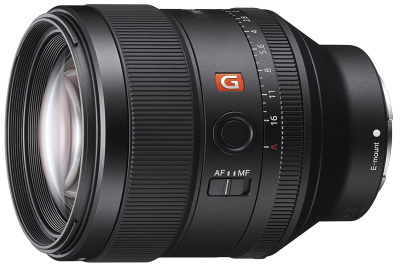
The Ultimate Portrait Prime
Often referred to as the perfect focal length for portraiture, the Sony FE 85mm f/1.4 GM is a fast short-telephoto prime distinguished by its flattering field of view, advanced optics, and ability to isolate subjects with shallow depth of field. As a G Master lens, too, this lens offers refined sharpness and bokeh quality, championing a pleasing image quality well-suited for portraits, events, and other situations where focus control is paramount.
Pros
- Very fast lens – focusing is a breeze.
- The build quality is quite solid and durable.
- Very sharp and clear images.
- The depth of field is more natural rather than dreamy, which I find to be positive.
- Excellent flare resistance.
Cons
- Noticeable chromatic aberration in high contrast situations.
- Visible vignetting at wide apertures.
- The lens has a significant weight.
- The price is a bit steep
Specification
| Focal Length | 85mm |
|---|---|
| Maximum Aperture | f/1.4 |
| Minimum Aperture | f/16 |
| Lens Mount | Sony E |
| Lens Format Coverage | Full-Frame |
| Angle of View | 29° |
| Minimum Focus Distance | 2.62' / 80 cm |
| Maximum Magnification | 0.12x |
| Optical Design | 11 Elements in 8 Groups |
| Diaphragm Blades | 11, Rounded |
| Focus Type | Autofocus |
| Image Stabilization | No |
| Filter Size | 77 mm (Front) |
| Dimensions (ø x L) | 3.52 x 4.23" / 89.5 x 107.5 mm |
| Weight | 1.8 lb / 820 g |
-
Sony FE 90mm f/2.8 Macro G OSS
FE G OSS
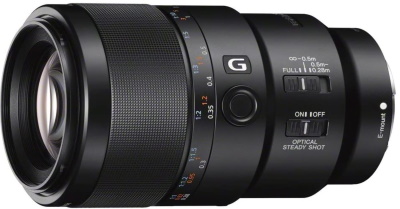
Get up close and personal with the 1:1 magnification ratio of the full-frame compatible Sony FE 90mm f/2.8 Macro G OSS Lens. As a G series lens, it perfectly balances sharpness and bokeh and, as a macro lens, close and controlled focusing performance is prioritized with advanced AF and intuitive handling.
Pros
- Nice build quality
- The clutch mechanism works flawlessly and allows a true mechanical manual focus
- the focus motor is quiet, fast, and smooth
- Eye AF works well
- Excellent resolution and contrast across the frame
- Good control of aberrations
- OSS is effective
Cons
- Expensive
- 62mm filter thread is uncommon
Specification
| Focal Length | 90mm |
|---|---|
| Max Aperture | f/2.8 |
| Min Aperture | f/22 |
| Lens Mount | Sony E |
| Lens Format | Full-Frame |
| Angle of View | 27° |
| Minimum Focus Distance | 11.02" / 28 cm |
| Maximum Magnification | 1x |
| Macro Reproduction Ratio | 1970-01-01 01:01:00 |
| Diaphragm Blades | 9, Rounded |
| Focus Type | Autofocus |
| Image Stabilization | Yes |
| Filter Size | 62 mm (Front) |
| Dimensions (ø x L) | 3.11 x 5.14" / 79 x 130.5 mm |
| Length at Maximum Extension | 5.12" / 130.1 mm |
| Weight | 1.32 lb / 602 g |
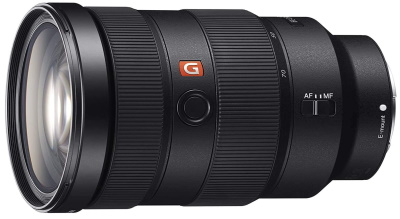
A fast, standard zoom favored for its versatility, the Sony FE 24-70mm f/2.8 GM is a wide-angle to a short telephoto lens featuring advanced G Master optics, a robust physical design, and a bright f/2.8 constant maximum aperture. A go-to lens for a variety of shooting situations, the 24-70mm f/2.8 is a perfect choice for landscape, sports, and portraiture subjects
Pros
- Attractive carry weight and size
- Superb optical performance
- Snappy autofocus response
- Zoom tension control and linear manual focus
- Useful on-barrel controls
- 1:3.1 macro reproduction
Cons
- Pricey
- Some focus breathing
Specification
| Focal Length | 24 to 70mm |
|---|---|
| Max Aperture | f/2.8 |
| Min Aperture | f/22 |
| Lens Mount | Sony E |
| Lens Format | Full-Frame |
| Angle of View | 84° to 34° |
| Minimum Focus Distance | 1.2' / 38 cm |
| Maximum Magnification | 0.24x |
| Diaphragm Blades | 9, Rounded |
| Focus Type | Autofocus |
| Image Stabilization | No |
| Filter Size | 82 mm (Front) |
| Dimensions (ø x L) | 3.4 x 5.4" / 87.6 x 136 mm |
| Length at Maximum Extension | 6.6" / 167 mm |
| Weight | 1.9 lb / 886 g |
-
Sony FE 135mm f/1.8 GM
FE GM
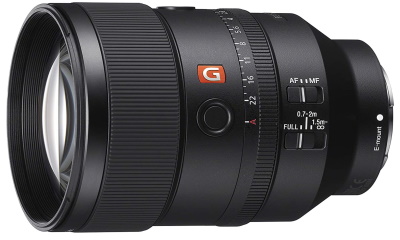
The FE 135mm f/1.8 GM from Sony is a medium telephoto prime characterized by a bright and sophisticated design. Perfect for portraiture, this lens also excels in close-range sports shooting and has a unique focal length for landscape subjects. Its G Master design prioritizes both sharpness and bokeh quality and the lens also sports fast autofocus capabilities and durable build quality.
Pros
- Beautiful, feature-rich build
- Magnesium alloy core and thorough weather sealing
- Amazing autofocus with brilliant speed and accuracy
- Eye AF is so good that portrait work is a joy
- Record-setting sharpness and contrast
- Lovely bokeh and color
- Great handling and performance
- Truly exceptional
Cons
- Expensive
- Somewhat flare-prone in certain situations
Specification
| Focal Length | 135mm |
|---|---|
| Max Aperture | f/1.8 |
| Min Aperture | f/22 |
| Lens Mount | Sony E |
| Lens Format | Full-Frame |
| Angle of View | 18° |
| Minimum Focus Distance | 2.3' / 70 cm |
| Maximum Magnification | 0.25x |
| Diaphragm Blades | 11, Rounded |
| Focus Type | Autofocus |
| Image Stabilization | No |
| Filter Size | 82 mm (Front) |
| Dimensions (ø x L) | 3.52 x 5" / 89.5 x 127 mm |
| Weight | 33.51 oz / 950 g |
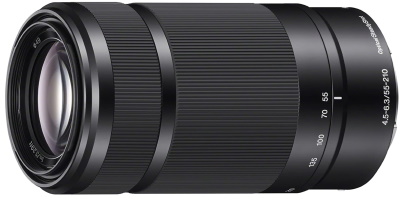
An ideal complement to many kits zooms, the black E 55-210mm f/4.5-6.3 OSS Lens from Sony opens the door to many telephoto perspectives with its 82.5-315mm equivalent focal length range on APS-C-format E-mount cameras. This portrait-length to mid-tele reach is ideal for a range of subjects, from portraits to distant sports and landscapes, and its sleek size also makes it a great travel companion.
Pros
- Light, compact design.
- zoom range= 3.8x
- Solid telephoto reach.
- Optical stabilization.
Cons
- So-so image quality.
- Omits weather sealing.
Specification
| Focal Length | 55 to 210mm (35mm Equivalent Focal Length: 82.5 to 315mm) |
|---|---|
| Max Aperture | f/4.5 to 6.3 |
| MinAperture | f/22 to 32 |
| Lens Mount | Sony E |
| Lens Format | APS-C |
| Angle of View | 29° to 7° 40' |
| Minimum Focus Distance | 3.28' / 1 m |
| Maximum Magnification | 0.23x |
| Diaphragm Blades | 7, Rounded |
| Focus Type | Autofocus |
| Image Stabilization | Yes |
| Filter Size | 49 mm (Front) |
| Dimensions (ø x L) | 2.51 x 4.25" / 63.8 x 108 mm |
| Length at Maximum Extension | 6" / 152.5 mm |
| Weight | 12.17 oz / 345 g |
-
Sony E 70-350mm f/4.5-6.3 G OSS
E G OSS
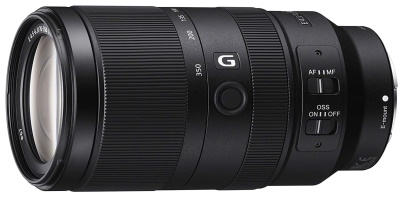
Versatile Telephoto Zoom for APS-C. The E 70-350mm f/4.5-6.3 G OSS from Sony is a 105-525mm-equivalent zoom for APS-C-format E-mount cameras. The long reach is suitable for sports, wildlife, and landscape shooting, and is benefitted from Optical SteadyShot image stabilization to minimize the appearance of camera shake for sharper handheld shooting.
Pros
- Nicely built lens
- weather sealing
- Very effective optical stabilizer
- Extremely fast and quiet autofocus
- Good tracking capabilities
- Consistently excellent sharpness and contrast
- Good bokeh rendering
- Good control of chromatic aberrations
- Low vignette
- Compact size and weight for the zoom range
Cons
- Slightly expensive
- Flare prone
- Some pincushion distortion
Specification
| Focal Length | 70 to 350mm (35mm Equivalent Focal Length: 105 to 525mm) |
|---|---|
| Max Aperture | f/4.5 to 6.3 |
| Min Aperture | f/22 to 32 |
| Lens Mount | Sony E |
| Lens Format | APS-C |
| Angle of View | 22° to 4° 40' |
| Minimum Focus Distance | 3.61' / 1.1 m |
| Maximum Magnification | 0.23x |
| Diaphragm Blades | 7 |
| Focus Type | Autofocus |
| Image Stabilization | Yes |
| Filter Size | 67 mm (Front) |
| Dimensions (ø x L) | 3.03 x 5.59" / 77 x 142 mm |
| Length at Maximum Extension | 7.48" / 190 mm |
| Weight | 1.38 lb / 625 g |
Related posts
Best Sony FE Lenses – My 6 Top Picks!
Sigma Lens For Sony E Mount- Go For The Affordable Option
Sony Lenses For A6000 – The Top For All Budgets!
Thanks for reading, I hope you enjoyed the article, in case you have any questions just drop them below & I will be happy to answer you.
If you enjoy the site, don’t forget to subscribe, we will only inform you when a new article is posted.






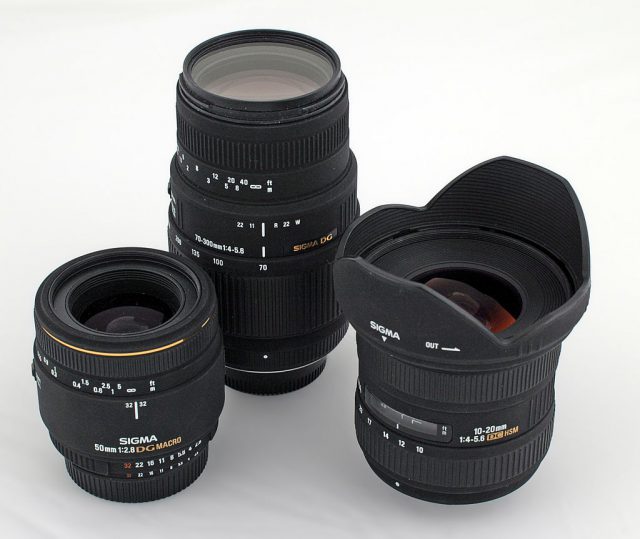


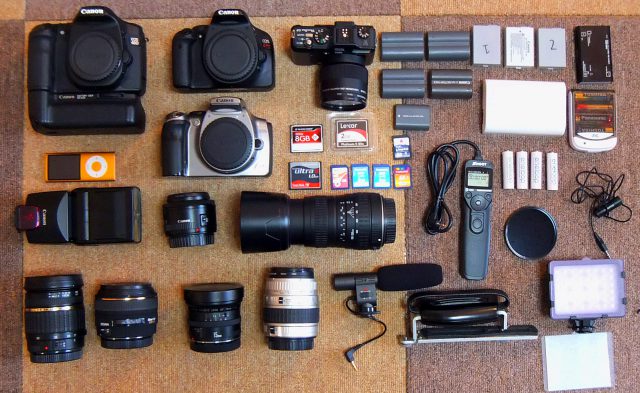
Thanks for this article. In my opinion, Sony digital camera lenses are some of the best on the market. They are made with high-quality materials and are designed to produce stunning images.
One of the great things about Sony lenses is that they are compatible with a wide range of Sony digital cameras. This means that you can use the same lens with multiple cameras, which makes it easier to keep your equipment organized and easy to use.
Sony lenses are also very affordable, which makes them a great option for budget-minded photographers.
Overall, Sony digital camera lenses are a great choice for anyone looking for high-quality, affordable photography equipment. Which lens to choose? I’m no expert, but this blog post explains the inner details for your requirements.
Many thanks for your great comment.
I got started with my YouTube channel some months back. I am beginning to see a use for my camera and understand the lens. Combining the full frame and camera is very different from connecting the full frame camera and APS lens. But honestly, you may not see it unless you are into production.
Thank you for the omment
This website on Sony camera has been well- researched, and has provided an extensive information regarding the variety of lenses to use. The G Master , being Sony’s new highest quality range of lenses, offering the highest resolution as opposed to the G – Gold, which is now Sony’s old highest quality range of lenses.
The amount of research placed to provide us information as to the type of lenses to use that would serve what needs to be accomplished is vast. Your passion to your love of photography cannot be denied.
Very impressive website on photography and the Sony camera.
I am glad you like the article, I really appreciate your comment, thanks.
This is a great article. I must say, I am not too familiar with Sony Cameras or Sony lenses as I always had a Nikon in the past. You have put together a great resource for a budding or professional photographer. What would you recommend as the best value general purpose lens for someone making the switch from Nikon?
Thanks for your comment, I really like Sony FE 24-70mm f/2.8 G Master
I have a Cannon, so I take it you can’t use Sony lenses on a Cannon? I never realized that Sony had become so sophisticated with their lenses, and hopefully the other camera companies will follow suit.
Why would a photographer choose a prime lens over a zoom lens, apart from the fact that the picture quality seems slightly better. Is there a reason that there are prime lenses that don’t need to be adjusted by zooming in or out? I can’t imagine taking photos without having that feature.
Thanks for your comment. Generally, prime lenses are lighter, smaller, and have a wider aperture (which is useful to get a shallow depth of field, nice bokeh, suitable for low light situations) and they produce sharper images
Didn’t know Sony had such an extensive range of lenses. Obviously the most known is carl zeiss as this name comes in a wide variety of Sony products and relate to consumers the most. I have a DSLR from Sony that I bought many years ago and I am still very happy with it. I have the standard lenses it came with but since I am most of an amateur user I never needed much more. Glad to learn more from this amazing hobby.
Sony became the world leader in mirrorless cameras, so their lens lines are huge and have many options.
Thanks for your feedback. I hope you continue enjoying your hobby. Wish you all the best.
This is a very comprehensive list of Sony lenses for digital cameras, that will satisfy the needs of anybody looking for digital camera lense. I am a beginner photographer and currently have a Pentax camera that was kindly given to me.
Would these Sony lenses be compatible with Pentax? If they are compatible, which one would you recommend as the best for a beginner? I am mainly taking photographs of nature and the ocean at the moment. Thank you.
Unfortunately, Sony and Pentax cameras have different lens mounts, so you cannot use Sony lenses on your Pentax camera. Even if you search for an adaptor to match them, I suspect you can find any.
Thanks for your comment
A lot of information for people considering buying a camera. My grandson is a “Filmer” for his skateboard team, he was fascinated by your comparisons and recommendations for the cameras and lenses. Although I am not into photography, your cohesive and complete reviews of the cameras and lenses will help my grandson decide which camera he will purchase in the near future. A very thorough review of the subject matter by someone who is obviously an expert. I appreciate your complete and honest reviews of the subject. Very well done.
Thanks for your feedback
Thank you so much for sharing the best picks for Sony Digital Camera Lenses!
I have many cameras and I love the Sony cameras more than Canon or Nikon.
The lenses are so much better quality and in my experience they are a lot more durable!
Thank you for sharing this info, I’ve always wondered about the different attachments, mounts, etc…
I’ve learned so much from this post!
Glad you find the article useful, thanks for the comment
Thanks a lot for this valuable detailed post about Sony digital camera lenses. I really like photography. I also have a sony camera. I hope that I will be able to find a good lens. I have a normal lens. I hope to buy this sony e 55-210mm. Keep posting like this. I definitely share this.
Thanks, you are welcome